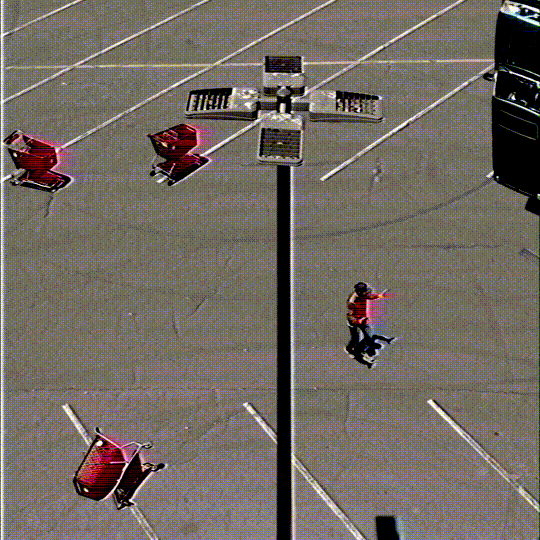IMN #36 — Joe Pease

It's Monday Night #36
Tonight, let’s share thoughts about @joepease's work: the mess of late capitalism urban life swallowed, digested and vomited in short loops by the Internet's subconscious.
The artworks of @joepease display images repeated in endless loops. They have the opaque thickness and impossible clarity of a hallucination: it is a wide-eyed view of an indecipherable reality, both insignificant and overloaded with meaning.
Each video has the texture and brightness of a slightly miscalibrated cathode ray television: slight crackling, too much radiation intensity, saturated colours that burn the eyes, etc.
An accident has occurred, affecting both the medium (the format) and the subject (the content): @joepease depicts a scene that lacks meaning through a dysfunctional or deteriorated medium.
Each clip is like a loop that revolves around an empty or absent centre: an event that occurs but cannot be understood; an event that occurred but may have been forgotten, repressed - all that remains are traces, symptoms that reveal and mask what happened.
I see in all his plays a doomed attempt to appropriate a trauma through the repetition of the traumatic scene - trauma sometimes being the fact that something happens (a fall, a rupture, etc.) and sometimes that something does NOT happen (the coming catastrophe never happens).
There is, of course, the intuition that in the great metropolises of late capitalism people are similar, but also, perhaps more profoundly, that they divide and multiply without ceasing to be identical to themselves.
On the one hand, @joepease's work highlights the collective achievement of any large metropolis of late capitalism: millions of people in simultaneous and contradictory movements that almost never result in accidents.
A city is 10,000 disasters (fires, car accidents, breakdowns, etc.) avoided every second. In other words: virtually every second, 10,000 disasters occur.
One only has to look at any busy road, any pedestrian crossing, to realize the permanent miracle of urban life: maximum interaction in minimum space.
Algorithmic or cybernetic enigma of metropolitan population behavior: the principle of entropy - the tendency to disorganization and chaos - is constantly neutralized or counterbalanced.
To the outside eye, everything happens as if by magic or thanks to the expertise of an omniscient conductor hidden off-screen.
Bodies brushing against each other without touching, speeding cars without giving rise to the slightest fear: all the movements seem to be choreographed and nothing disturbs the quiet - almost mechanical - pace of the passers-by.
What interests @joepease is collective automatisms: this harmony between thousands of small individual decisions and the organisation that jumps out at the observer.
On the other hand, @joepease insists that there is no such thing as a miracle: the city is not that orchestra that plays a perfect melody in a pre-established harmony when the musicians have never met.
On the contrary, the metropolis of late capitalism is not just 10,000 accidents avoided every second, it is 100,000 accidents that occur.
These little slip-ups, these failures that are constantly repressed by the collective imagination, which prefers to remain ignorant of its own weirdness.
It is the brutal event of the fall of a body - a human body or an object that obviously functions as an allegory of a human body.
While all movements are progressive and horizontal (running, sliding, rolling, flying), the movement of the fall is sudden, abrupt and vertical: it bursts into the field and crashes to the ground - like someone who falls off their skateboard.
The effect that such a fall produces is that of relaxation and enlightenment: a bit like the fall of a joke, which by mixing superficial absurdity and deeper wisdom - unless it is the opposite.
This is the reason why @joepease's loops tickle us so much and why we can't look at them without feeling a great desire to laugh:
with him, everywhere, the mechanical is plastered on the living, but the living revolts and it is this revolt that makes us laugh, because it is both grotesque and tragic.
In @joepease's work, reality acts as a break-in that disrupts reality without interrupting the loop: first, because everyone is looking the other way, and second, because everything is happening at such a speed that there is paradoxically no room for a break.
So @joepease dissects like an anatomist the movements of the urban animals that we are: no exchange of glances, no contact or attention to the environment; no interiority either, it seems:
each character divides themself through their own movement in a way that does not disturb the scene in the least.
Individuals can substitute each other ad infinitum; and they can even substitute themselves. At the same time, @joepease proposes an artistic and visually delirious reinterpretation of Zeno's old paradox.
Zeno is the one who claimed to demonstrate that the arrow can never reach the target because space is infinitely divisible (it has to travel half the way, then half of the half and so on, conclusion: movement is conceptually unthinkable, it is a logical impossibility).
In @joepease, the formula is a bit different: what he shows is that individuals cannot remain identical to themselves through their movement and that they become someone else at each step of their trajectory.
It shows how, in order to go from point A to point B, subjectivity is divided, how it is transformed into a multitude of bodies that do the same thing without coinciding with each other.
He plays with the vertigo of identity in a post-modern and playful reinterpretation. He captures, through his dystopian kaleidoscope, something essential about the great contemporary cities of a globalized world.